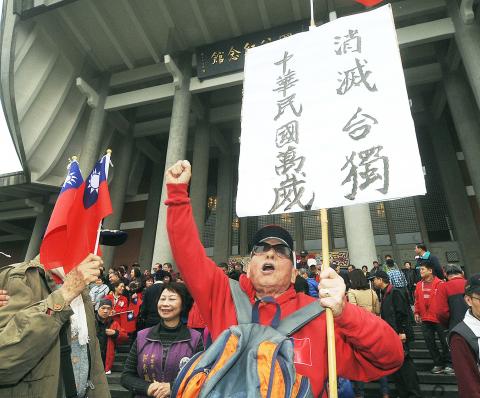“Brutal anti-democratic” acts that defaced a statue of the nation’s founding father cannot erase the fact that Taiwan shares a deep history with Sun Yat-sen (孫逸仙) and the Chinese revolution, President Ma Ying-jeou (馬英九) said yesterday.
Many people in Taiwan had helped repatriate Taiwan to the Republic of China (ROC), such as Lien Chen-tung (連震東), Hsieh Tung-min (謝東閔) and Lee You-pang (李友邦), Ma said at a ceremony in Taipei commemorating the 89th anniversary of Sun’s death.
Eighteen delegates from Taiwan attended the 1946 People’s Assembly to ratify the ROC Constitution, and numerous Taiwanese had also helped in campaigns launched by former president Chiang Kai-shek (蔣介石) during the Second Sino-Japanese War, all of which illustrate the bond Taiwan shares with Sun’s revolution, Ma said.

Photo: Fan Pin-chao, Taipei Times
Large portraits of Taiwanese who have fought for the nation, including Chiang Wei-shui (蔣渭水), Monaludo (莫那魯道), Lo Fu-hsing (羅福星) and Liao Chin-ping (廖進平) have also hung outside the KMT’s headquarters since Ma’s first term as KMT chairman in 2005.
“We are always thankful for what these forerunners of democracy did for Taiwan,” Ma said.
His comments were seen as a rebuke to Alliance of Referendum for Taiwan members who, led by alliance convener Tsay Ting-kuei (蔡丁貴), toppled a statue of Sun in the center of a Greater Tainan park on Feb. 23, saying it had a damaged base and posed a risk to public safety.
Pro-localization groups had complained that the statue overshadowed the commemorative bust of 228 Incident hero Tang Te-chang (湯德章), for whom the park is named.
Ma said he wondered how those who toppled the statue “could face Chiang Wei-shuei, who is commonly called the “Sun Yat-sen of Taiwan” after such act of “anti-democratic brutality.”
Another commemorative event for Sun was held by the New Party and other organizations to back calls for the Greater Tainan Government to address the incident.
Such an incident should not have happened in a democratic country, New Party Chairman Yok Mu-ming (郁慕明) said.
Yok said Sun’s statue must be restored and that there would be demonstrations if action was not taken.
China Unification Promotion Party leader Chang An-le (張安樂) also protested what he said was a lack of action by the Greater Tainan Government.
He visited the park yesterday to pay his respects at the site and shouted a round of slogans.
He then gave Tainan Secretariat Secretary-General Hsiao Po-jen (蕭博仁) a letter of complaint.
Meanwhile, the Filipino Chinese Cultural and Economic Association and the Sun Yat-sen Society in the Philippines paid for a notice in Chinese-language newspapers yesterday that condemned the alliance for downing Sun’s statue.
“We roundly condemn the barbaric act that has angered all Chinese compatriots in the country and abroad,” the notice said, adding that the act was a “release of barbarism by people walking into the dead end of Taiwanese independence.”
The two organizations called for the alliance members involved to apologize publicly and to have the statue repaired.

SHIPS, TRAINS AND AUTOMOBILES: The ministry has announced changes to varied transportation industries taking effect soon, with a number of effects for passengers Beginning next month, the post office is canceling signature upon delivery and written inquiry services for international registered small packets in accordance with the new policy of the Universal Postal Union, the Ministry of Transportation and Communications said yesterday. The new policy does not apply to packets that are to be delivered to China, the ministry said. Senders of international registered small packets would receive a NT$10 rebate on postage if the packets are sent from Jan. 1 to March 31, it added. The ministry said that three other policies are also scheduled to take effect next month. International cruise ship operators

HORROR STORIES: One victim recounted not realizing they had been stabbed and seeing people bleeding, while another recalled breaking down in tears after fleeing A man on Friday died after he tried to fight the knife-wielding suspect who went on a stabbing spree near two of Taipei’s busiest metro stations, Taipei Mayor Chiang Wan-an (蔣萬安) said. The 57-year-old man, identified by his family name, Yu (余), encountered the suspect at Exit M7 of Taipei Main Station and immediately tried to stop him, but was fatally wounded and later died, Chiang said, calling the incident “heartbreaking.” Yu’s family would receive at least NT$5 million (US$158,584) in compensation through the Taipei Rapid Transit Corp’s (TRTC) insurance coverage, he said after convening an emergency security response meeting yesterday morning. National

PLANNED: The suspect visited the crime scene before the killings, seeking information on how to access the roof, and had extensively researched a 2014 stabbing incident The suspect in a stabbing attack that killed three people and injured 11 in Taipei on Friday had planned the assault and set fires at other locations earlier in the day, law enforcement officials said yesterday. National Police Agency (NPA) Director-General Chang Jung-hsin (張榮興) said the suspect, a 27-year-old man named Chang Wen (張文), began the attacks at 3:40pm, first setting off smoke bombs on a road, damaging cars and motorbikes. Earlier, Chang Wen set fire to a rental room where he was staying on Gongyuan Road in Zhongzheng District (中正), Chang Jung-hsin said. The suspect later threw smoke grenades near two exits

The Forestry and Nature Conservation Agency yesterday launched a gift box to market honey “certified by a Formosan black bear” in appreciation of a beekeeper’s amicable interaction with a honey-thieving bear. Beekeeper Chih Ming-chen (池明鎮) in January inspected his bee farm in Hualien County’s Jhuosi Township (卓溪) and found that more than 20 beehives had been destroyed and many hives were eaten, with bear droppings and paw prints near the destroyed hives, the agency said. Chih returned to the farm to move the remaining beehives away that evening when he encountered a Formosan black bear only 20m away, the agency said. The bear